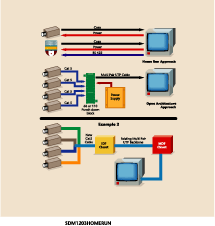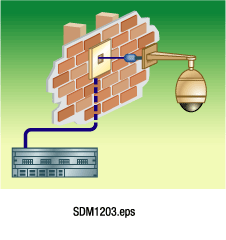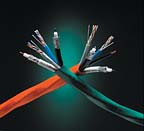

SPECIALTY CABLE – MADE FOR A PURPOSE
A “specialty cable†is a combination of conductors, often using different types of media, such as coax and UTP (unshielded twisted pair), under an overall outer jacket. Such cables are typically designed to provide specific connection capabilities, such as UTP and coax for home structured cabling systems, where media outlets will have a combination of telecommunications/computer network jacks and TV connections.A number of manufacturers have stepped forward to provide specialty cables that can reduce labor costs when installing high-end systems. Genesis Cable Systems, Pleasant Prairie, Wis., provides a variety of “multimedia†cables that bundle combinations of Cat 5e UTP and RG6 coax for residential use. Because they are packaged in an overall jacket, cable installation time is reduced when compared to pulling separate conductors. The thickness of these cables reduces the possibility of excessive bending during installation, which can damage UTP conductors or reduce their signaling capability.
Home theatre wiring systems utilize new technologies such as HDTV (High Definition Television), and require higher grades of cabling for proper operation. Manufacturers such as Isotec, Des Plaines, Ill., provide purpose-built products such as the “Sheer Sound†RGBHV Mini Digital Coaxial cable, which meets HDTV and digital requirements, according to the manufacturer.
Such cables may require the use of specific types of connectors or termination. Installers should take extra care when terminating such cables; many performance problems can be traced to a poorly attached connection appliance.
PRE-INSTALLED CABLE PLANTS
The introduction of network devices has opened a wide new opportunity for security integration companies. Millions of miles of UTP, fiber optics, and other cables have already been installed for communications applications in commercial enterprises around the country, and around the world. The proper planning and usage of these existing communication routes will spell the difference in profitability of installations, and providing the end user with the system features that they desire.The ubiquitous presence of UTP cabling in commercial structures is a direct result of the growth in popularity of Ethernet computer network systems.
In conjunction with high performance cable, communications networks within buildings are generally designed, installed, and tested to meet rigorous standards established by such bodies as the EIA/TIA (Electronics Industry Association/ Telecommunications Industry Association). When the installation is performed properly, the cabling network provides a communications platform that is robust, reliable, and has ready connection opportunities spread throughout the structure.
Because of this standardized approach, these existing cabling networks offer great advantages to security integrators who are ready to utilize them. As the cabling network is already installed, there can be great installation time and cost savings when connecting remote security devices. Because the products and installation generally conform to industry standards, the existing cable path can be utilized for security signaling with a high degree of confidence on the part of the installation firm. As UTP cable typically contains four twisted pairs, multiple signals and power can be transmitted and received from remote security devices.
As clients become more concerned about the security of their physical plant and personnel, the security industry has seen tremendous growth in the use of CCTV and video imaging. Vendors now supply a variety of products to connect cameras to their monitoring equipment using existing UTP cabling systems.

CCTV AND UTP
One innovative product now available is the “CCTP†system from Anixter, Glenview, Ill. In conjunction with Phillips, this vendor has developed a line of transmission and receiving devices that will transmit video signal, power, and control on one 4-pair UTP cable. This system carries UL certification, and is standards compliant with the EIA/TIA. Cameras are connected using special jumper cables, with standard connection fixtures on one end and a UTP RJ-45 plug on the other, to be connected to a structured cabling wall outlet. This system is well suited when planning a new CCTV installation in a large building that has an existing structured cabling network installed.When adding a few cameras to an existing CCTV installation, modules that combine camera, control, and power transmission are available from Nitek, Rolling Meadows, Ill. This vendor is producing a wide variety of simple and effective UTP video transmission devices that can encompass complete installations or a small number of cameras. Of particular interest is the VB43 series, which combines the transmission of video, power, and RS422 control signaling into a very compact package that can be easily fitted into dome cameras and housings. With transmission distances up to 1000 feet, these low cost transceivers can be readily deployed using existing UTP networks. The Nitek Linx system is a complete UTP video solution, providing video, power, and control signals to a large CCTV installation.
Although many structures have existing UTP (unshielded twisted pair) cabling networks, such cable plants are not usually optimized for usage by security integration companies. Without careful consideration, contractors may find that their system cannot be installed as planned and that the security of the system is easily compromised.

INSTALLATION ISSUES
Using existing cable networks for security systems pre-supposes that the cabling installation was performed properly. Any deviation in termination, cable support, or other issues may render the selected cable path unusable for security applications.A key concern is whether there is the necessary number of unused cable pairs available for the planned installation. Although cabling industry standards call for extra pairs to be available within a telecommunications panel, the cautious security integrator should check to ascertain that the requisite number of unused pairs are available and their location. If the unused pairs terminate in a telecommunications closet, it is possible that the original contractor did not test them for functionality. Simple testers that will quickly verify that the conductors in question are not broken are available from companies such as Ideal Industries, Sycamore, Ill.
Once the available pairs have been located, the next issue is connecting the remote security device to the UTP network. This will likely involve the installation of new Cat 5e/6 4-pair UTP cable from the device location to the telecommunications closet. Proper installation of UTP cable requires careful pulling, as excess tension will tend to straighten out the pair twists under the cable jacket, affecting data throughput and increasing the potential for interference. The installer should be prepared to connect such cables with RJ-45 appliances, male and female, or using a punch-down tool, typically a 110 style. The screw terminations commonly used in security devices do not provide the solidity of connection required for data applications.
If pre-wired RJ-45 jacks have been installed near the proposed location of a CCTV camera or security device, it is tempting to simply plug the camera’s output into the jack using a short jumper cable. However, as easy as it is for an installer to plug in the camera, it is also that easy for the camera to be disconnected. Because pre-installed jacks are typically installed low on the wall, to facilitate easy computer and telephone connection, unplugging devices is easily done. One alternative is to install a new jack plate, high on the wall near the camera, with new UTP connecting it to the telecommunications closet. Another approach is provided by Nitek, who manufacturers their VB43F transceivers in a “PD†(punch down) version, allowing the connection to be secured behind a blank wall plate or within the camera’s housing.
To comfortably work with existing structured cabling networks installers should be well versed in the basics of networking, device addressing, cable types, and the proper methods of termination and testing.
There are a variety of cable manufacturers whose products will meet every need for low voltage applications. Increasing, products are available that utilize existing cable networks to provide connectivity for security and life safety communications. Using existing cable plants can spell the difference between obtaining or not obtaining the contract, and can significantly impact the profitability of the installation.
